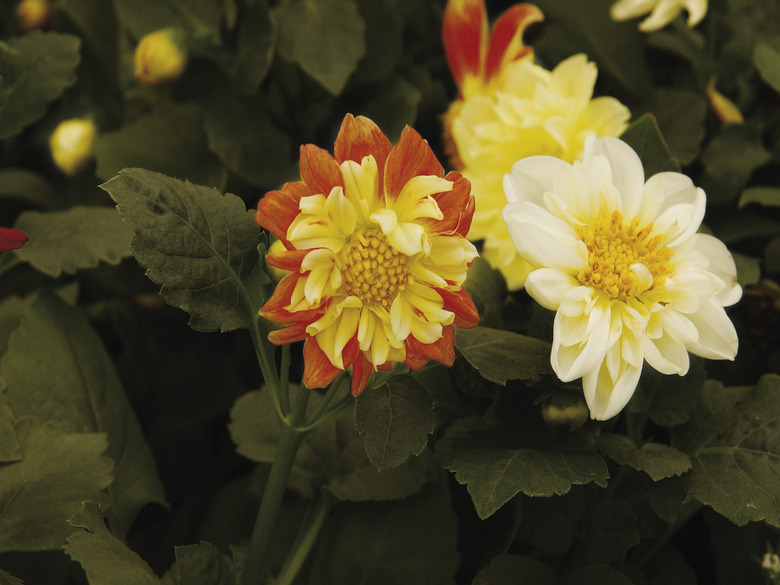How To Transplant Dahlias
Dahlias (Dahlia spp.) are flowering plants that range in size from 1 foot wide and tall to 3 feet wide and 6 feet tall. They are hardy in U.S. Department of Agriculture plant hardiness zones 8 through 10. In cooler climates, their tuberous roots must be stored indoors for the winter. Large tubers can be transplanted into the garden two weeks before the last expected frost. Small tubers and seedlings must not be transplanted until two weeks after the last spring frost.
Step 1
Step 1
Choose an area for the dahlias where the soil drains quickly and they will get at least six hours of direct sunlight each day. Test the soil pH in the fall prior to planting the dahlias. They grow best in soil with an acidic pH between 6 and 6.5. Use a shovel or tiller to mix sulfur into the soil to lower the pH, or lime to raise the pH. Amend the soil in the fall to allow enough time for the pH to change. The amount of sulfur or lime added to the soil must be determined according to how much the pH needs to be changed and the soil texture. It takes less sulfur or lime to adjust sandy soil than loamy or clay soil.
- are flowering plants that range in size from 1 foot wide and tall to 3 feet wide and 6 feet tall.
- Large tubers can be transplanted into the garden two weeks before the last expected frost.
Step 2
Step 2
Spread a 2- to 4-inch layer of organic matter over the planting area along with 2 to 4 tablespoons of 8-8-8 or 10-10-10 fertilizer per square foot in the spring prior to planting the dahlias. The organic matter can be aged manure, compost, composted pine bark mulch, leaf mold or sphagnum peat moss. A combination of different types of organic matter can be used. Mix the soil amendments into the soil thoroughly with a tiller or shovel to a depth of 8 to 10 inches. Continue to turn and mix the soil until the amendments are completely incorporated and the soil is fine-textured without any clumps.
Step 3
Step 3
Dig up dahlia tubers that have been growing in the garden but need to be moved. Push a garden fork into the soil 1 foot away from the tubers. Do this in a circle around the tubers to loosen the soil. Push the garden fork in again and pull the handle back and down to lift the tubers up. Divide larger tubers before replanting them. Use a sharp knife to cut them into sections that have at least one eye or small bump where the stem will grow. Spread the sections out on a tray, and let them sit for a few days in a garage or shed to allow the cut ends to dry.
- Spread a 2- to 4-inch layer of organic matter over the planting area along with 2 to 4 tablespoons of 8-8-8 or 10-10-10 fertilizer per square foot in the spring prior to planting the dahlias.
- Use a sharp knife to cut them into sections that have at least one eye or small bump where the stem will grow.
Step 4
Step 4
Use a dirt shovel to dig the planting holes 9 to 12 inches deep, depending on the mature size of the dahlia. Space the tubers the same distance apart as their mature width. Dig 9-inch-deep holes for varieties that are 1 foot tall and wide and space them 1 foot apart. Dig 12-inch-deep holes for larger 4- to 6-foot-tall, 3-foot-wide varieties and space them 3 feet apart. Pile the soil behind each planting hole.
Step 5
Step 5
Put a 6-inch depth of the soil that was just removed from the planting hole back into the hole. This provides a nice, loose base beneath the tuber for the roots to grow into. Lay the tuber on its side in the hole with the eyes up. Spread 1 to 2 inches of soil over the tuber. Do not fill the hole up all the way or tamp the soil down. Water the tuber to moisten and settle the soil.
- Use a dirt shovel to dig the planting holes 9 to 12 inches deep, depending on the mature size of the dahlia.
- Dig 12-inch-deep holes for larger 4- to 6-foot-tall, 3-foot-wide varieties and space them 3 feet apart.
Step 6
Step 6
Maintain consistently moist soil. Add more soil to the planting hole as the stems grow until the soil over the tuber is level with the surrounding soil. Spread a 2- to 3-inch layer of mulch over and around the tubers to conserve water after the stems are about 6 inches tall.
Tip
You can buy a soil test kit at a garden center. Local Extension offices will do the soil test for a small fee and can recommend appropriate soil amendments and application rates.
Things Needed
- Soil pH test
- Shovel
- Tiller (optional)
- Sulfur (optional)
- Lime (optional)
- Organic matter
- Fertilizer
- Garden fork (optional)
- Sharp knife (optional)
- Tray (optional)
- Tape measure
- Organic mulch
References
- Floridata: Dahlia spp.
- Missouri Botanical Garden: Dahlia (Group)
- North Carolina Cooperative Extension Service: Dahlias for the Home Landscape
- Clemson University: Clemson Cooperative Extension: Home & Garden Information Center: Changing the pH of Your Soil
- University of Minnesota: SULIS: Amending Soils for Perennial Beds
- Oregon State University Extension Service: Improving Garden Soils With Organic Matter
